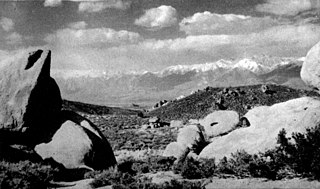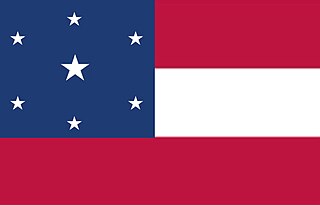Related Research Articles

The Battle of San Pasqual, also spelled San Pascual, was a military encounter that occurred during the Mexican–American War in what is now the San Pasqual Valley community of the city of San Diego, California. The series of military skirmishes ended with both sides claiming victory, and the victor of the battle is still debated. On December 6 and 7, 1846, General Stephen W. Kearny's US Army of the West, along with a small detachment of the California Battalion led by a Marine Lieutenant, engaged a small contingent of Californios and their Presidial Lancers Los Galgos, led by Major Andrés Pico. After U.S. reinforcements arrived, Kearny's troops were able to reach San Diego.

The Powder River Expedition of 1865 also known as the Powder River War or Powder River Invasion, was a large and far-flung military operation of the United States Army against the Lakota Sioux, Cheyenne, and Arapaho Indians in Montana Territory and Dakota Territory. Although soldiers destroyed one Arapaho village and established Fort Connor to protect gold miners on the Bozeman Trail, the expedition is considered a failure because it failed to defeat or intimidate the Indians.

California's involvement in the American Civil War included sending gold east to support the war effort, recruiting volunteer combat units to replace regular U.S. Army units sent east, in the area west of the Rocky Mountains, maintaining and building numerous camps and fortifications, suppressing secessionist activity and securing the New Mexico Territory against the Confederacy. The State of California did not send its units east, but many citizens traveled east and joined the Union Army there, some of whom became famous.

The Pacific coast theater of the American Civil War consists of major military operations in the United States on the Pacific Ocean and in the states and Territories west of the Continental Divide. The theater was encompassed by the Department of the Pacific that included the states of California, Oregon, and Nevada, the territories of Washington, Utah, and later Idaho.
Galvanized Yankees was a term from the American Civil War denoting former Confederate prisoners of war who swore allegiance to the United States and joined the Union Army. Approximately 5,600 former Confederate soldiers enlisted in the United States Volunteers, organized into six regiments of infantry between January 1864 and November 1866. Of those, more than 250 had begun their service as Union soldiers, were captured in battle, then enlisted in prison to join a regiment of the Confederate States Army. They surrendered to Union forces in December 1864 and were held by the United States as deserters, but were saved from prosecution by being enlisted in the 5th and 6th U.S. Volunteers. An additional 800 former Confederates served in volunteer regiments raised by the states, forming ten companies. Four of those companies saw combat in the Western Theater against the Confederate Army, two served on the western frontier, and one became an independent company of U.S. Volunteers, serving in Minnesota.

Thomas Harbo Rynning was an officer in the United States Army who served with Theodore Roosevelt's Rough Riders during the Spanish–American War. He was also the captain of the Arizona Rangers, warden of Yuma Territorial Prison, and a United States Marshal in San Diego, California.

The 1st Oregon Infantry Regiment was an American Civil War era military regiment recruited in Oregon for the Union Army. The regiment was formed in November 1864. At full strength, it was composed of ten companies of foot soldiers. The regiment was used to guard trade routes and escorted immigrant wagon trains from Fort Boise to the Willamette Valley. Its troops were used to pursue and suppress Native American raiders in eastern Oregon and the Idaho Territory. Several detachments accompanied survey parties and built roads in central and southern Oregon. The regiment's last company was mustered out of service in July 1867.
The 1st Nevada Cavalry Battalion, or the Nevada Territory Cavalry Volunteers, was a unit raised for the Union army during the American Civil War. It remained in the west, garrisoning frontier posts, protecting emigrant routes, and engaged in scouting duties. The unit was disbanded in July 1866.
The California Battalion was formed during the Mexican–American War (1846–1848) in present-day California, United States. It was led by U.S. Army Brevet Lieutenant Colonel John C. Frémont and composed of his cartographers, scouts and hunters and the California Volunteer Militia formed after the Bear Flag Revolt. The battalion's formation was officially authorized by Commodore Robert F. Stockton, commanding officer of the U.S. Navy Pacific Squadron.

The 1st Regiment California Cavalry was a cavalry regiment in the Union Army during the American Civil War. It was first formed as the 1st Battalion, 1st Regiment California Cavalry between August and October 31, 1861, at Camp Merchant near Oakland. After the battalion was organized it was sent to Southern California, with three companies stationed at Camp Latham, near Los Angeles, and two at Camp Carleton, near San Bernardino. From November 20–29, 1861, the detachment under Second Lt. C. R. Wellman was stationed at Camp Wright, and pursued and captured Dan Showalter's party west of the San Jose Valley and Warner's Ranch. The battalion remained in Southern California until the spring of 1862 when it became part of the California Column and formed the advance force of that Column during the march to New Mexico Territory and Texas. In 1863 seven more companies were raised to bring the regiment to a full strength of twelve companies. The five companies first organized were mustered out August 31, 1864, as the terms of service of most of the men had expired. Two new companies, B and C, were organized in New Mexico by consolidation of the few men whose terms had not expired, and by new enlistments, and two new companies were enlisted in California, A and E, and then sent to Arizona. All of the companies of First California Cavalry stationed in New Mexico and Texas, were ordered to assemble at Baird’s Ranch, near Albuquerque, to be mustered out of the service during September, 1866. Company M was the last mustered out on the September 30, 1866. The 1st California Cavalry Regiment spent its entire term of service in the western United States in California and New Mexico Territory and Texas.
The 1st Battalion of Native Cavalry, California Volunteers was a cavalry battalion in the Union Army during the American Civil War. Recruits were largely drawn from the Californio population, though its ranks included Yaqui and Mission Indians as well as immigrants from Mexico, Hispano America and Europe. In addition to its ethnic makeup, the Battalion is also considered unusual for being one of the few lancer units in the United States Army.
John Hicks Adams (1820–1878) was an American 49er of the California Gold Rush and sheriff of Santa Clara County between 1864 and 1870, and again between 1871 and 1875. He was also Deputy United States Marshal for the Arizona Territory 1878, and a noted gunslinger.
John Mason, with Jim Henry, was one of the leaders of the Mason Henry Gang organized by secessionist Judge George Gordon Belt. The group posed as Confederate partisan rangers, but acted as outlaws, committing robberies, thefts and murders in the San Joaquin Valley, Monterey County, Santa Clara County, Santa Cruz County and later in the counties of Southern California.

The Owens Valley War was fought between 1862 and 1863 by the United States Army and American settlers against the Mono people and their Shoshone and Kawaiisu allies in the Owens Valley of California and the southwestern Nevada border region. The removal of a large number of the Owens River indigenous Californians to Fort Tejon in 1863 was considered the end of the war. Minor hostilities continued intermittently until 1867.

The Mason Henry Gang were bandits operating in Central and Southern California in 1864–1865. As the Civil War was in progress, they were able to pose as Confederate Partisan Rangers, and their original mission was to rid the area of (anti-slavery) Republicans. But when it became clear that the Confederate cause was lost, they turned to outlawry, plundering and killing without mercy.
Camp Babbitt was an American Civil War Union Army camp located in two sites in the vicinity of Visalia, California.

The Wytheville Raid or Toland's Raid was an attack by an undersized Union brigade on a Confederate town during the American Civil War. Union Colonel John Toland led a brigade of over 800 men against a Confederate force of about 130 soldiers and 120 civilians. The location of Wytheville, the county seat of Wythe County in southwestern Virginia, had strategic importance because of a nearby lead mine and the railroad that served it. This mine supplied lead for about one third of the Confederate Army's munitions, while the Virginia & Tennessee Railroad transported Confederate troops and supplies; plus telegraph wires along the railroad line were vital for communications. In addition to logistics of moving the lead to bullet manufacturing facilities, this rail line also connected an important salt works of an adjacent county with the wider Confederacy.
The Skirmish near Fort Thorn, New Mexico Territory, also known as the Fight at E Company Grove, was a skirmish of the American Civil War on the morning of September 26, 1861. It followed the Battle of Canada Alamosa one of several small battles that occurred near the border between Confederate Arizona and Union New Mexico Territory. This one being an attempt by detachments of three companies of the Union Regiment of Mounted Rifles to pursue the Confederate cavalry force of Captain Bethel Coopwood's San Elizario Spy Company, and detachments of Company B and E, Second Texas Mounted Rifles, that was retiring from their victory at Canada Alamosa toward their base at Camp Robledo, 12 miles north of Dona Ana, New Mexico.
On April 19, 1865, Secessionists skirmished with 25 troopers of the 1st California Cavalry Battalion in Grass Valley, California in the wake of the assassination of Abraham Lincoln.
The Battle of Sulphur Springs was an ambush by members of the 1st California Cavalry Battalion on the Chiricahua in Sulphur Springs Valley, Arizona. It was the only engagement fought in General Mason campaign against Cochise 1865–1866.
References
- 1 2 3 Historic California Posts: Camp Low, California State Military Department, The California Military Museum website, accessed September 26, 2013
- ↑ William N. Abeloe ed., Mildred B. Hoover, Hero. E. Rench, Ethel G. Rench, Historic Spots in California, Third Edition, Stanford University Press, Stanford, 1966, p.311
- ↑ South San Juan, April 12th, 6 pm. Lieutenant Lafferty and detachment returned this moment, bringing with them the captured horse of the murderer Mason. The detachment surprised Mason at seven o'clock this morning, at the head of the Great Panoche Valley. The murderer made the most desperate attempt to escape and finally succeeded, but not until his horse was shot and he himself badly wounded in the hips by a shot from the Lieutenant's pistol. The commanding officer, Captain Jimeno, will send another detachment immediately to keep up the hunt until Mason is either killed or captured. (Alta California [San Francisco], April 13, 1865; 1:7)